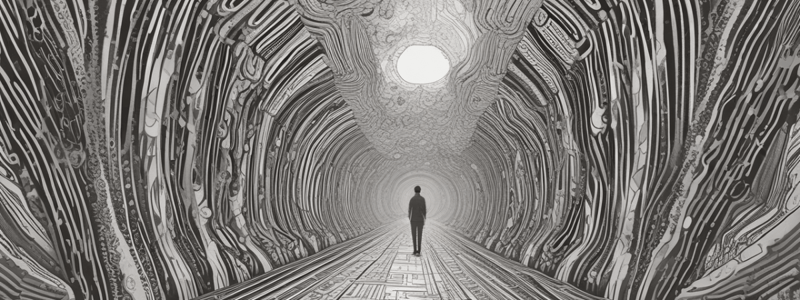Podcast
Questions and Answers
Which of the following best describes the automatic nature of sensory stimulation?
Which of the following best describes the automatic nature of sensory stimulation?
- It results only from visual stimuli.
- It requires conscious effort to interpret stimuli.
- It is triggered by external energy sources or chemicals. (correct)
- It is dependent on individual perception.
What is the primary psychological process involved in knowing reality?
What is the primary psychological process involved in knowing reality?
- Sensation (correct)
- Memory
- Perception
- Cognition
Which sensory modality is primarily involved in the perception of depth and motion?
Which sensory modality is primarily involved in the perception of depth and motion?
- Vision (correct)
- Hearing
- Touch
- Taste
What happens to the sensation of touch when a hand is held still over a surface?
What happens to the sensation of touch when a hand is held still over a surface?
Which body parts are the most sensitive to touch due to a higher density of nerve endings?
Which body parts are the most sensitive to touch due to a higher density of nerve endings?
Which statement about the vestibular sense is accurate?
Which statement about the vestibular sense is accurate?
What initiates the visual sensations that we perceive?
What initiates the visual sensations that we perceive?
What would likely happen if a person lacked kinesthetic sense while walking?
What would likely happen if a person lacked kinesthetic sense while walking?
Which part of the ear acts as a sound wave funnel to the eardrum?
Which part of the ear acts as a sound wave funnel to the eardrum?
Which of the following is NOT one of the four primary taste qualities identified by researchers?
Which of the following is NOT one of the four primary taste qualities identified by researchers?
What is the role of the middle ear?
What is the role of the middle ear?
Flashcards are hidden until you start studying
Study Notes
Sensation and Cognition
- Sensation is the primary psychological process for perceiving reality, allowing cognitive functions to reflect on objects and phenomena.
- Sensory receptors are stimulated by energy sources (light, sound) and chemicals (smell, taste), transmitting information to the central nervous system.
- Neurons in sensory organs, such as the eyes, convey information to the sensory cortex in the brain.
- David Hubel and Torsten Wiesel's research identified feature detectors in the visual cortex that respond to specific aspects of visual input.
- Different types of feature detectors exist for various senses, including visual and auditory stimuli.
Skin Senses
- Skin contains nerve endings that respond to contact, producing sensations like temperature, pain, and pressure.
- Various receptors for touch detect constant or intermittent pressure, requiring active engagement (moving hand) to maintain sensory input.
- Sensitivity to touch varies by body part, with fingertips and face being more sensitive due to denser nerve endings and a larger portion of the somatosensory cortex.
Temperature Sensation
- Temperature receptors in the skin respond to changes in warmth and cold, with sensations being relative and adaptable.
- Environmental factors affect temperature perception, such as the initial coldness of water that feels warm after acclimation.
Pain Perception
- 89% of adults experience pain monthly, with older adults often attributing it to aging, while younger individuals link it to stress or lifestyle.
- Pain signals motivate adaptive behavior; chronic pain can diminish quality of life and vitality but is sensed most acutely in areas with dense nerve endings.
Kinesthesis and Vestibular Sense
- Kinesthesis provides feedback on body position and movement through sensory organs in joints and muscles, essential for coordinated movement.
- The vestibular sense helps maintain balance and orientation, with sensory organs in the inner ear monitoring body motion and position relative to gravity.
Vision
- Vision is the dominant sense, with light being a crucial component for visual sensation; it's part of the electromagnetic spectrum with varying wavelengths.
- The eye consists of the cornea, iris, and pupil, which regulate the amount of light entering and adjust according to environmental conditions.
- Pupil size is influenced by light and emotional states, with sympathetic arousal causing dilation.
Hearing
- Sound is characterized by vibrations and can be measured in frequency (pitch) and amplitude (loudness), both vital for auditory perception.
- The ear has three parts: outer, middle, and inner, with the outer ear funneling sound, the middle ear amplifying it, and the inner ear transmitting signals to the brain.
Taste and Smell
- Taste, a chemical sense, involves taste buds detecting flavors such as sweet, sour, bitter, saline, and umami, which is essential for food safety.
- The flavor experience combines taste, smell, texture, and temperature, with individual sensitivity to these elements varying among people.
- Smell plays a significant role in behavior and food flavor, with receptor neurons in the olfactory regions transmitting odour information directly to the brain.
Studying That Suits You
Use AI to generate personalized quizzes and flashcards to suit your learning preferences.




